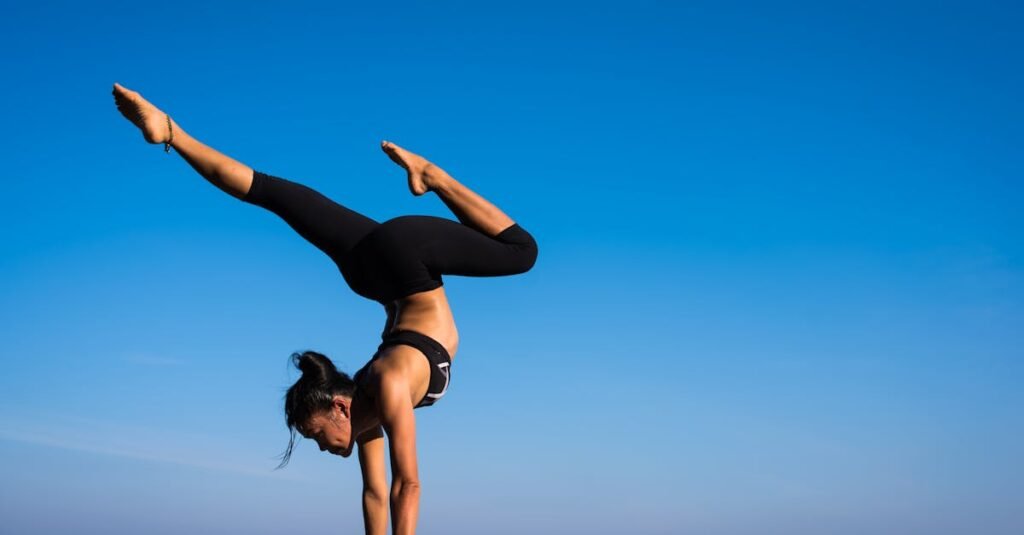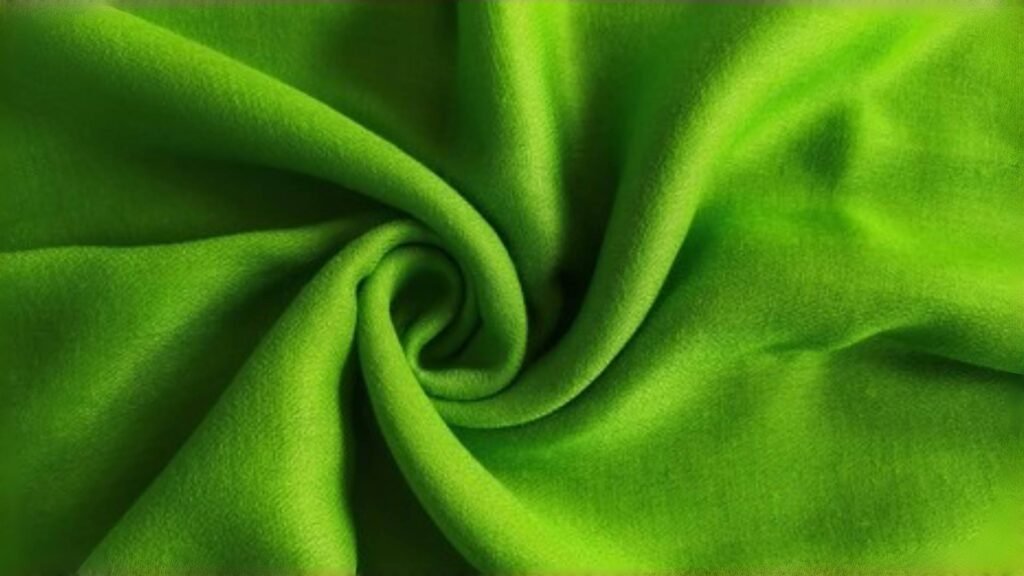In today’s activewear market, nylon and polyester are among the most commonly used materials for yoga pants. But are they truly the best options?
If you are planning to start your new business on activewear ,how will you choose ?
When it comes to performance, comfort, and longevity, the fabric you choose makes all the difference.
To determine the best yoga pants material, we need to consider five essential factors:
Stretch & Recovery – How well the fabric moves with you and retains its shape.
Comfort – The softness, feel, and overall wearability of the fabric.
Breathability & Moisture-Wicking – How well the material keeps you cool and dry.
Durability & Pilling Resistance – How the fabric holds up over time and with frequent washes.
- Sustainability-If it will damage the environment
In this post, we’ll explore five popular yoga pants fabrics, comparing their pros and cons across these key aspects. Let’s dive into the details and help you find the best material for your yoga pants business.
1.Polyester Yoga Pants
Polyester is a synthetic fiber derived primarily from petroleum-based sources. It’s widely used in athletic wear due to its durability, shape retention, and moisture-wicking abilities. Often blended with spandex (also known as elastane or Lycra), polyester forms the backbone of many yoga pants on the market today.
Pros and Cons of Polyester Yoga Pants
Let’s see the overall situation as below picture showed ,then you will see the specific reason.
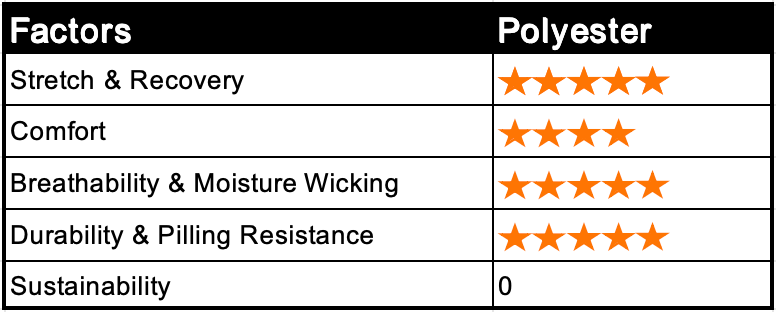
1) Stretch & Recovery
✅ Pros:
- When blended with spandex, polyester offers excellent stretchin all directions (4-way stretch).
- It provides great recovery, meaning it returns to its original shape after stretching—ideal for active movements and complex yoga poses.
⚠️ Cons:
- Lower-quality polyester blends may lose elasticity over time
2) Comfort
✅ Pros:
- Modern polyester fabrics are engineered to be soft and smooth against the skin, reducing irritation.
- It is lightweight, making it suitable for dynamic practices like power yoga or vinyasa.
⚠️ Cons:
- It can retain odors more than natural materials, especially in hot yoga environments.
3) Breathability &Moisture Wicking
✅ Pros:
- One of polyester’s biggest strengths is its moisture-wicking capability. It pulls sweat away from the skin and allows it to evaporate quickly, keeping you dry during workouts.
- It dries faster than cotton, reducing discomfort from soaked fabric.
⚠️ Cons:
- Although it wicks moisture, polyester is not as breathableas natural fibers, which can make it feel warm during long sessions.
4) Durability & Pilling Resistance
✅ Pros:
- Polyester is highly durable, maintaining its shape and color even after many washes.
- It has strong resistance to shrinking, wrinkling, and abrasions.
- High-quality polyester blends often show better resistance to pillingcompared to other synthetics.
5) Sustainability
✅ Pros:
- Obviously it is harmful for environment,the polyester’s original material is petroleum.
2.Cotton Yoga Pants
Cotton is a natural fiber harvested from the seed hairs of the cotton plant. It has been used in textiles for thousands of years and is one of the most widely used fibers in the world today. Known for its softness, breathability, and skin-friendly properties, cotton remains a popular choice for everyday clothing — including yoga pants.
However, cotton’s performance can vary depending on the quality of the fabric, the knitting method, and whether it’s blended with other fibers such as spandex or polyester.
Pros and Cons of Cotton Yoga Pants
Let’s see the overall situation as below picture showed ,then you will see the specific reason.
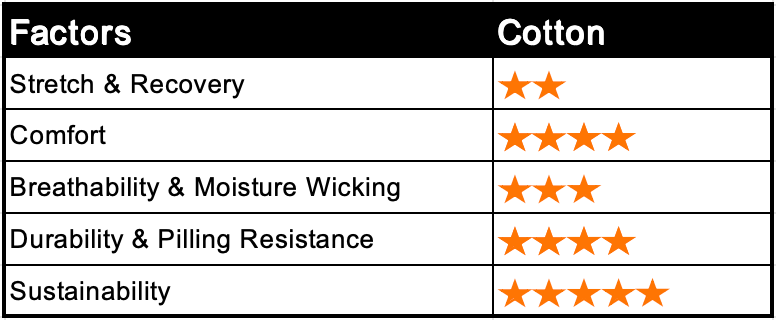
1)Stretch & Recovery
✅ Pros:
- When blended with elastane (e.g., cotton-spandex blend), cotton yoga pants can provide decent stretch, allowing for flexibility during yoga poses.
⚠️ Cons:
- 100% cotton has very limited stretch and poor recovery. After repeated movements, the fabric may lose shape or sag, especially around knees and hips.
- Compared to synthetic fibers, cotton doesn’t “snap back” well after stretching.
2)Comfort
✅ Pros:
- Cotton is soft, breathable, and gentle on the skin. It’s hypoallergenic, making it ideal for those with sensitive skin.
- Provides a natural, non-clingy feel that many people find relaxing.
⚠️ Cons:
- Cotton may feel heavy or soggy when damp from sweat.
- In tight-fitting designs, cotton can sometimes feel restrictive without the proper stretch blend.
3)Breathability & Moisture Wicking
✅ Pros:
- Cotton is a breathable fiber that allows air to circulate, helping to keep the body cool.
⚠️ Cons:
- Cotton absorbs moisture instead of wicking it away. Once it gets wet, it stays wet — which can lead to discomfort, chafing, or feeling cold during cool-down periods.
- Slow drying time compared to synthetic fibers.
4) Durability & Pilling Resistance
✅ Pros:
- High-quality cotton fabrics (especially combed or ring-spun cotton) can be quite durable if cared for properly.
- Cotton resists pilling better than some synthetic fibers, particularly when it’s tightly woven.
⚠️ Cons:
- Cotton is prone to shrinkage and color fading over time.
- Thinner cotton fabrics may wear out or develop holes at stress points more quickly.
5)Sustainability
✅ Pros:
- Natural & Eco-friendly
3.Bamboo Yoga Pants
What is Bamboo Fabrics?
Bamboo is a fast-growing, renewable plant that has become increasingly popular in the textile industry due to its minimal environmental impact. Bamboo can grow up to 3 feet a day, requires no pesticides, and regenerates naturally—making it a sustainable raw material.
When it comes to clothing, bamboo fibers are most commonly processed into bamboo viscose (or bamboo rayon) through a chemical process that turns bamboo pulp into a soft, drapey fabric. There is also mechanically processed bamboo, sometimes labeled as bamboo linen, but it’s more labor-intensive and less common in activewear.
While the eco-friendliness of bamboo fabric depends on the processing method, the final textile—especially bamboo viscose—is known for being soft, breathable, and moisture-wicking.
Pros and Cons of Bamboo Yoga Pants
Let’s see the overall situation as below picture showed ,then you will see the specific reason.
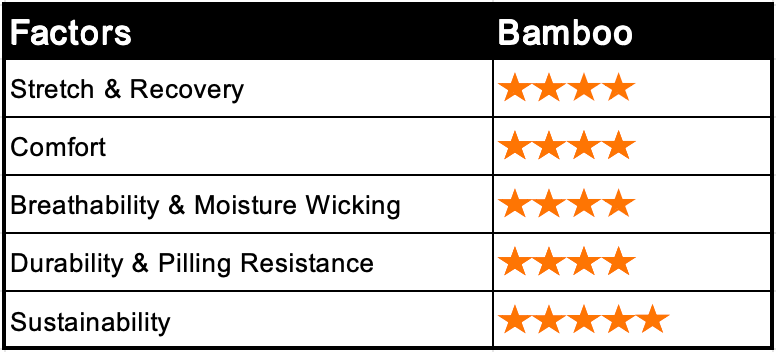
1) Stretch & Recovery
✅ Pros:
- Bamboo fabric is often blended with spandex or elastane, which gives yoga pants the necessary stretch for a full range of motion.
- It moves well with the body, making it suitable for yoga, pilates, and light workouts.
⚠️ Cons:
- Check the fabric composition—look for a blend (e.g., bamboo + 10% spandex) for optimal stretch and recovery.
2) Comfort
✅ Pros:
- Bamboo fabric is incredibly soft and smooth, often compared to silk or cashmere.
- It’s hypoallergenicand gentle on sensitive skin, with a natural feel that reduces irritation.
⚠️ Cons:
- Bamboo fabric can be less compressivethan synthetic alternatives, so those seeking firm support or shaping may find it too relaxed.
3) Breathability & Moisture Wicking
✅ Pros:
- Bamboo has natural moisture-wicking and thermo-regulating properties, helping to keep you cool in hot yoga or warm climates.
- The fabric is breathableand dries relatively quickly.
⚠️ Cons:
- While breathable, bamboo isn’t always as fast-dryingas high-performance synthetic fabrics (like polyester or nylon used in athletic gear).
4) Durability & Pilling Resistance
✅ Pros:
- Bamboo blends tend to be durable with proper care, especially when combined with stronger fibers.
- The fabric resists color fadingand holds its softness after multiple washes.
⚠️ Cons:
- Bamboo viscose can be prone to pilling, especially if not blended with durable materials or washed with rougher fabrics.
5) Sustainability
✅ Pros:
- Natural & Eco-friendly
4. Merino Wool Yoga Pants
Merino wool comes from Merino sheep, a breed known for producing some of the finest and softest wool in the world. Unlike traditional wool, which can be itchy and heavy, Merino fibers are ultra-fine, soft, and lightweight, making them suitable for wearing directly against the skin.
Pros and Cons of Merino Wool Yoga Pants
Let’s see the overall situation as below picture showed ,then you will see the specific reason.
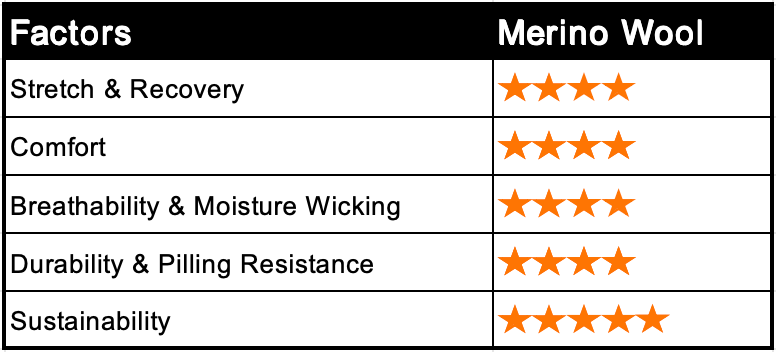
1) Stretch & Recovery
✅ Pros:
- Merino wool is often blended with elastane or nylon, which gives the pants good stretch and recovery, allowing for full movement during yoga practice
- Merino fibers are naturally elastic, which helps them return to shape after being stretched.
⚠️ Cons:
- Pure Merino wool doesn’t have the same level of snappy stretchas synthetic fabrics or high-stretch blends.
- If the blend isn’t well-constructed, the fabric might lose its shape over time, especially with heavy use.
2) Comfort
✅ Pros:
- Merino wool is incredibly soft and non-itchy, especially in fine-gauge knits. It’s comfortable even on sensitive skin.
- It naturally regulates body temperature, providing comfort across different climates—warm in winter, cool in summer.
- It also has natural odor resistance, which keeps you feeling fresher during and after workouts.
⚠️ Cons:
- Some people may still be sensitive to even the softest wool.
- Merino garments can be more expensive, though many users feel the comfort and performance are worth it.
3) Breathability & Moisture Wicking
✅ Pros:
- Merino wool is highly breathableand excellent at moisture management—it absorbs sweat vapor and releases it into the air, keeping your skin dry.
- Unlike synthetic fabrics that trap moisture on the surface, Merino fibers can hold up to 30% of their weight in moisturewithout feeling wet.
⚠️ Cons:
- Merino may take longer to drycompared to synthetic performance fabrics.
- In very hot and humid conditions, some may prefer lighter fabrics like bamboo or technical synthetics.
4) Durability & Pilling Resistance
✅ Pros:
- High-quality Merino blends with nylon or other durable fibers tend to hold up well over time, especially if used for activewear.
- Merino has natural elasticity, which helps it resist sagging.
⚠️ Cons:
- Pure Merino wool is more delicate and can be prone to pillingor wear if not reinforced with stronger materials.
- Requires gentle care (often cold wash, air dry) to maintain shape and texture.
5) Sustainability
✅ Pros:
- Natural & Eco-friendly
5.Recycled Polyester Yoga Pants
Recycled polyester (rPET) is a sustainable alternative to virgin polyester. It is typically made by melting down used plastic bottles (PET) or discarded polyester fabrics and re-spinning the material into new fibers. This process helps divert plastic waste from landfills and reduces the demand for petroleum-based raw materials.
Recycled polyester retains many of the same properties as traditional polyester, including strength, stretch, moisture-wicking abilities, and resistance to wrinkles. The key difference is in its lower environmental footprint—producing rPET uses significantly less water and energy compared to virgin polyester.
Pros and Cons of Recycled Polyester Yoga Pants
Let’s see the overall situation as below picture showed ,then you will see the specific reason.
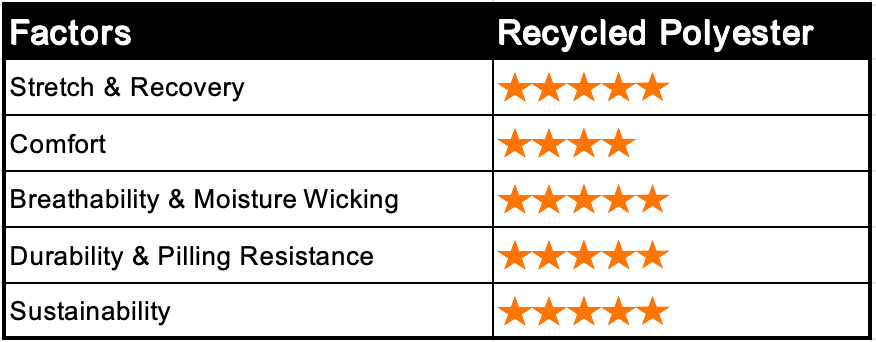
1) Stretch & Recovery
✅ Pros:
- Recycled polyester is often blended with spandex (elastane), providing excellent four-way stretchthat moves effortlessly with your body.
- The recovery—or the fabric’s ability to return to its original shape after being stretched—is typically strong, making these pants ideal for dynamic movements and deep stretches.
2) Comfort
✅ Pros:
- Recycled polyester is lightweight and smoothagainst the skin, often with a sleek, second-skin feel.
- It doesn’t absorb water, so it avoids that heavy, damp feeling during sweaty workouts.
⚠️ Cons:
- It lacks the natural softnessof materials like bamboo or Merino wool.
3) Breathability & Moisture Wicking
✅ Pros:
- One of recycled polyester’s strongest features is its moisture-wicking ability—it pulls sweat away from the body and dries quickly.
- Keeps you feeling cool and dry, even during hot yoga or high-intensity sessions.
⚠️ Cons:
- May trap odormore than natural fibers, requiring more frequent washing.
4) Durability & Pilling Resistance
✅ Pros:
- Recycled polyester is highly durable, resistant to tears, shrinking, and general wear and tear.
- It holds color well and maintains shape even after frequent washes.
- With proper blends, it offers strong resistance to pilling—a key concern in yoga pants.
5) Sustainability
✅ Pros:
- Natural & Eco-friendly
Conclusion
From 5 factors to consider ,we may know what is the best one for yoga pants.
If you would like choose just sustainable fabrics,the recycled polyester fabric is the best choice.
If you would like choose pure natural fabrics,the bamboo fabric is the best choice.

Finally no matter which one fabrics you choose ,we can be your partner to develp your new products !–>Sustainable Activewear Manufacturer

